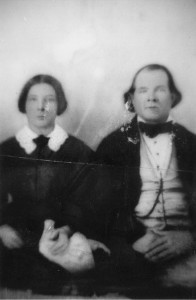One Door Closes, but Another Door . . .
Here’s a short recap—before the release of the 1940 census—of my search for mixed-race relatives descended from my white South Carolina ancestors:
Thomas is listed as a mulatto in the 1880 census. His Death Certificate names my great-grandfather Erasmus as his father, and Annie, a black woman, as his mother. Thomas was born in 1855. That’s how I recently learned that Thomas is my great uncle.
Curley, the son of Thomas (mulatto) and Anna (black), was born in 1892. His children would be my second cousins, and their children my second cousins once removed. Can I find them?
I’m following the trail forward. At least, I reflect, there is a trail!
Here’s one trail:
Erasmus & Annie –> Thomas & Anna –> Curley & Charlotte –> Curley’s children
Curley is in the 1900, 1910, and 1920 censuses, with our family surname. In 1910 he is one of seven children living with Thomas and Anna. In 1920 Curley and his wife Charlotte have four children of their own.
Yet Curley disappears from the Census in 1930.
Even when I “got narrow” as suggested by Susan Clark on Caroline Pointer’s blog site by searching for just the first name “Curley” anywhere in South Carolina, I struck out. (“Curley” seems unusual. The lead in Oklahoma is the only “Curley” I know.)
So the 1940 census was a ray of hope for me.
I searched an entire SC county on the 1940 Census, an eye-numbing 1500-plus online pages. No Curley, no Charlotte, none of their children’s first names.
No victory story here.
Yet I discovered I might be in a twisting Sherlock Holmes story, where one clue leads not to the solution but to another clue.
For as I wearily combed through the 1940 Census of the very last district in the county (42 districts!), I found Charlie. He had a wife, Annie, and three children. He also had the family surname.
Where had I seen this Charlie before? Ah, yes. He was an “adopted son” in a 1900 Census household, where the mother-in-law was . . . Annie!
And this Annie was the mother of Thomas, by my great-grandfather Erasmus. Thomas was born in 1855, back in slavery days.

Mary Caroline and Erasmus Goodson Kirven, c. 1850
In the 1900 Census, Annie at age 75 has Charlie listed as an “adopted son,” born in 1879. (Could Charlie be her grandson by her son Thomas? Charlie’s birth date is close to the 1880 Census that lists Thomas living with a wife and newborn daughter. Thomas’s mulatto son Charlie may have been placed with another black family for a while, as seems general practice from census records in this county.)
Also in this household live Annie’s son-in-law James W. (a different surname from ours) and Annie’s daughter Caroline W., born in 1850 and listed as mulatto on the 1880 census. Annie may have named her own daughter Caroline after Erasmus’ wife and my great-grandmother, Mary Caroline. Could Caroline W. have been Erasmus’ mulatto daughter by Annie, born five years before their mulatto son Thomas in 1855? (James and Caroline W. married in 1866, the year after the Civil War.)
So here’s another trail:
Erasmus & Annie –> Caroline
AND
Erasmus & Annie –> Thomas & Lucy –> Charlie & Annie –> Charlie’s children
Hm. Charlie’s children might also be my second cousins, like Curley’s children. Was this a second-best “find”?
On that 1900 census, Charlie bears our family surname. For whatever reason, Annie wanted that surname in her family.
Maybe she fought to keep that surname. On the 1880 census I found Charlie, 2 years old, mulatto, with father James W., black, and mother Caroline W., mulatto. Charlie has James’s W. surname, here. He is listed as “son” and not “adopted son.”
So Charlie’s name and status changed between 1880 and 1900. Did Annie prevail in some conflicted family discussions?
In 1910, Charlie is listed as widowed and mulatto.
In the county Draft Registration records of 1917-18, Charlie lists his birth year as 1876 and his wife Annie (once again, an Annie!) as his nearest relative. In 1930 he and Annie have an “adopted son,” Wilson. Adopted from whom? In 1940 he has another son and a daughter, all teenagers then.
The Death Certificate for Charlie says he died in June 1948 at age 70, which puts his birth year as 1878.
I looked for Charlie’s father. Thomas? Erasmus? Who? But this question drew a blank. The father was listed as D.K. (don’t know). A frustrating item for family researchers.
Did they really not know?
Are these D. K.’s, and adoptions, and variable birth years an effort to hide mixed-race parentage? For the benefit of whom?
Also in the 1940 census, there is a pattern of black families adopting children who keep the surname of well-known white families. Mixed-race parentage might have been a sign of status, as degree of “whiteness” is in some places today. The hierarchies of class and race are a sad phenomenon.
To look for Charlie’s mother, whose name was typed through a used ribbon over Death Certificate print, I “go wide” under Susan Clark’s advice. I search for Ce* and other variants of a first name that looks somewhat like Ceicilna. I come up empty.
Family research is engaging detective work, but difficult. Slippery.
I welcome all advice from readers and genealogy experts! Tips appreciated!
[P. S. In case others can benefit from my mistake: Archives.com appeared on my monitor, advertising their stockpile of records. When they claimed they had Curley’s “birth record,” I took the bait and gave them my credit card number to get a look. But they showed me only the 1900 census. No birth certificate. Buyer beware. I’m going to un-subscribe.]



